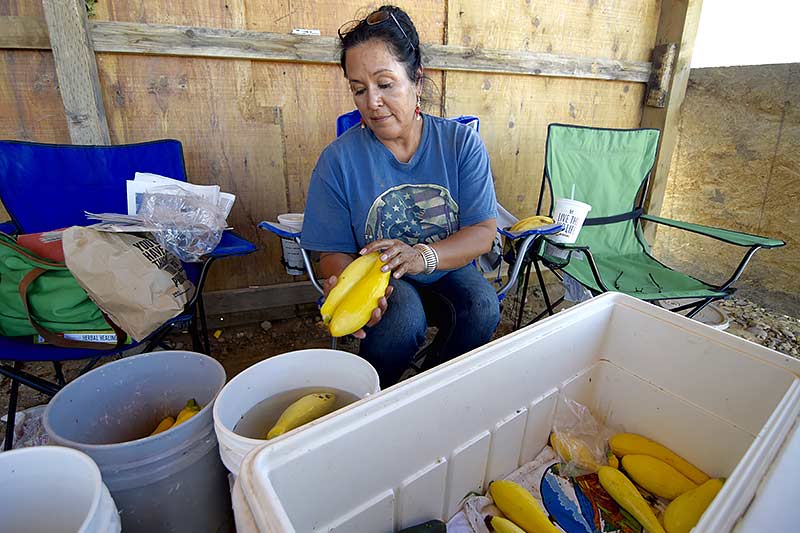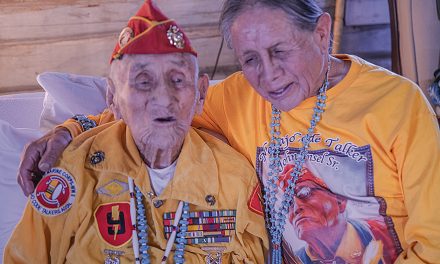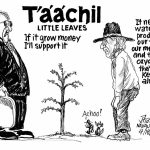
Letters: Thankful to families, farmers of Hogback

Sherrell Mesa moistures her squash at her sale booth Thursday in Hogback, N.M. EPA Administrator Gina McCarthy the EPA had set aside $500,000 to bring water to Navajo farmers along the San Juan. (Times photo - Donovan Quintero)
As a third generation farmer family member in Hogback Chapter I, too, have kept informed daily on our contamination of irrigation water here. For the bigger picture in Washington, D.C., one key individual is noticeably AWOL/MIA. Given the massive land/river base that is affected or will be affected. Starting in Durango, Colo., ending in the Gulf of California. The mass media and Congress continue to keep our crisis on the backburner. More importantly, not getting accountability of this individual.
The EPA has been incredibly slow in deploying massive assistance. State, county, cities, and the Navajo Nation have had to attack this crisis on their own. Blame the rest directly on one man, he’s the only person with the power to mobilize any and all related agency in getting badly needed resources to us. President Obama is being given a pass for non-responsiveness unavailable as the commander in chief. Both Navajo and off-reservation farmers have limited resources in holding their own. Where is President Obama?
New Mexico Governor Susanna Martinez, Rep. Sharon Clahchischilly and Navajo Nation President Russell Begaye deserve a lot of credit. They all were there within hours and continue to hold the EPA accountable.
All farmers share the devotion to the value of family, land, water, crops, and livestock. Without farmers, we wouldn’t have the corn pollen and crops we cherish, men and women who work the land 24/7 in good weather, bad weather, good times, and bad times. They so generously share harvest each year. Thankful, strong and proud caretakers of mother earth, should the worse happen, contamination of water and soil, all farmers would bare the hardship of long days and long nights, decades before the soul can heal. These are real men and women as opposed to the soft hands politician men and women in Washington, D.C.
I am thankful to the farmers and families of Hogback Chapter as we work through this crisis. All having that frame of mind “What can I do to help” and a special thank you to my younger brother, Lonnie Bernally, being there at the farm 24/7. Farmers are very important Diné.
Gary Bernally
Hogback, N.M.
Instead of chasing them off the land, build a plan with the feds
The recent accidental release of toxins into the Animas and San Juan rivers has affected many people from all walks of life. It directly affected the farmers and ranchers who utilize this water system for their livelihood. It indirectly affected the extended families, friends, relatives and many others who depend on these farmers and ranchers as customers and colleagues, as well as the many livestock. Our traditional people who have cultural and spiritual connections to the river and its vegetation have been severely disturbed. It was emotionally disheartening and distressing to observe our river contaminated and tainted with unknown chemicals and toxins.
As we patiently wait to be informed of the final results, we recommend and urge all affected, to record and make a journal of all problems this dilemma has created for them. Since all cases will not be the same, because of farm size, product or produce, or other use, we urge all to use their best judgment in making their final decisions when filing claims. While some may wait until both the USEPA and the NNEPA release their results to start using their irrigation system, others may want use the water as soon as one or the other entities release some test results. Because each case may differ, we urge you to not act in haste, but make the best decision based on your circumstance.
This incident should open our eyes to seek and implement a contingency plan, should another event of this magnitude take us by surprise. We should always be thinking several years ahead.
There seems to be ample supply of water feeding into the NAPI complex. We should encourage and assist our Navajo Nation leaders to evaluate what it would take to build an emergency backup plan with the thought of tapping NAPI water system into the Upper Fruitland canal system. Then connect this to all the irrigation system downstream to feed well beyond Shiprock. If Phoenix can fill their canals while being so far away from a river, we should be able to do likewise with the abundance of water in our backyard.
Not to be alarming, but the media revealed there are many abandoned mines in Colorado that could become potential hazards and evolve into and create the same problem we just experienced. Thus, this is an opportune time to ask the federal government to assist the Navajo Nation with implementing the “One Nation, One Voice” agreement in building a contingency plan, instead of chasing them off our land.
Ernie Yazzie
St. Michaels, Ariz.
‘Women of the tribes get the job done’
I just watched a program on PBS saying that 40 percent of Navajo people don’t have access to running water. They spoke of a woman named Darlene who drove a big water truck and George McGraw.
I can help the Navajo Nation, but I need an address to write to the tribal president. I would rather have Darlene’s address. The women of the tribes are the hard workers who get the job done.
John Jozwiak
Stanley, Wis.
Shouldn’t we be blaming the Gold Mine?
Earlier this month, a toxic spill had occurred releasing toxic materials into the Animas River, which would find its way through the Navajo Reservation and into Arizona. What I don’t understand is why are the people blaming the EPA and not the gold mine in Silverton, Colo.?
The EPA was established to mitigate risks like this but it is the gold mine’s responsibility to keep up-to-date with regulations. Shouldn’t the blame be placed on the gold mine that is destroying our beautiful land?
In 2014, the Navajo Nation was awarded $554 million dollars to settle claims that the U.S. government has mismanaged funds and natural resources on the Navajo Reservation for decades. To this day, I still have not seen how the Navajo Nation president and vice president plan to use these funds. Will they provide better roads? Will they begin construction to power or provide water piping to isolated locations for all our elders?
I am a recent construction management graduate and with my education and past work experiences, the average two-lane highway cost an estimated $850,000 per mile. Now, let’s do some simple calculations, divide $554 million by $850,000 and we get 651.8. In conclusion, we can pave 652 miles of two-lane highway. So if none of the $554 million dollars has been spent, we can pave a two-lane highway from Phoenix to San Diego then back to Phoenix.
In conclusion to my Diné people, imagine having 652 miles of paved highway, highways that can get you to work and also get your kids safely to school.
Jerson Hosteen
Pinon, Ariz.
To read the full article, pick up your copy of the Navajo Times at your nearest newsstand Thursday mornings!
Are you a digital subscriber? Read the most recent three weeks of stories by logging in to your online account.








 Highway 264,
Highway 264, I-40, WB @ Winslow
I-40, WB @ Winslow